Effect of Undercut Bolt Anchor Depth on Failure Cone Geometry: A Numerical FEM Analysis and Experimental Verification
Abstract
1. Introduction
2. Materials and Methods
Numerical Analysis
- Damage initiation in rock material: Maximal Principal Stress;
- Damage evolution: type: energy, softening linear;
- Damage for traction—separation laws: Maximal Principal Stress Damage;
- Fracture Energy EIc = 0.355 N/mm;
- Damage stabilization—cohesive, stabilization coefficient: 1 × 10−6.
- (a)
- Base mesh—the side length of the elements was set to 25 mm. In the contact area with the anchor, element sizes ranging from 2 to 5 mm were analyzed. Along the upper edge of the model, the element size varied from 2 to 10 mm. Along the predicted crack path, the base length of the elements was set to 4 mm. The mesh was composed of Axisymmetric Stress, linear, reduced integration, and 4-node type (CAX4R) elements. As a result, the total number of nodes was 8024, and the total number of elements was 7797 (for the M20 anchor, hef = 150 mm). Figure 4 illustrates the results obtained (finite element mesh, crack propagation trajectory, and the plot of maximum principal stress distribution σmax.
- (b)
- Mesh with Reduced Element Size
- (c)
- Mesh with enlarged element dimensions
3. Results and Discussion
3.1. Numerical Analysis
3.2. Experimental Validation
3.3. Limitations and Future Plans
- the interaction of undercut anchors with the rock medium,
- rocks treated as a homogeneous, isotropic-medium and devoid of heterogeneities and fractures.
4. Conclusions
Author Contributions
Funding
Institutional Review Board Statement
Informed Consent Statement
Data Availability Statement
Conflicts of Interest
References
- Eligehausen, R. Verankerungen von Fassaden; University of Stuttgart: Stuttgart, Germany, 1986. [Google Scholar]
- International Federation for Structural Concrete (fib). Design of Anchorages in Concrete: Guide to Good Practice; Eligehausen, R., Ed.; Bulletin/International Federation for Structural Concrete Guide to good practice; International Federation for Structural Concrete (fib): Lausanne, Switzerland, 2011; ISBN 978-2-88394-098-7. [Google Scholar]
- Eligehausen, R.; Fuchs, W.; Mayer, B. Tragverhalten von Dübelbefestigungen Bei Zugbeanspruchung; University of Stuttgart: Stuttgart, Germany, 1987; Teil 1. [Google Scholar]
- Stierschneider, E.; Zeman, O.; Bergmeister, K. Freeze-Thaw Behaviour of Post-Installed Bonded Anchors under Changing Climate Conditions. CivilEng 2022, 3, 332–346. [Google Scholar] [CrossRef]
- Mahrenholtz, P.; Eligehausen, R. Post-Installed Concrete Anchors in Nuclear Power Plants: Performance and Qualification. Nucl. Eng. Des. 2015, 287, 48–56. [Google Scholar] [CrossRef]
- CEN/TS 1992-4-1; Design of Fastenings for Use in Concrete-Part 4-1: General. NSAI: Dublin, Ireland, 2009.
- Bokor, B.; Sharma, A.; Pregartner, T. An Assessment Method to Ensure Applicability of Concrete Capacity Method for Design of Anchorages: Linear Force Distribution Approach. Struct. Concr. 2023, 24, 7249–7271. [Google Scholar] [CrossRef]
- Hilti. HDA Undercut Anchor; Technical Datasheet Update: Dec-17; Hilti: Schaan, Liechtenstein, 2017. [Google Scholar]
- Camposinhos, R.S. Undercut Anchorage in Dimension Stone Cladding. Proc. Inst. Civ. Eng. Constr. Mater. 2013, 166, 158–174. [Google Scholar] [CrossRef]
- Primavera, E.J.; Pinelli, J.P.; Kalajian, E.H. Tensile Behavior of Cast-in-Place and Undercut Anchors in High-Strength Concrete. ACI Struct. J. 1997, 94, 583–594. [Google Scholar] [CrossRef]
- Fuchs, W.; Eligehausen, R. Das CC-Verfahren Für Die Berechnung Der Betonausbruchlast von Verankerungen. Beton-Und Stahlbetonbau 1995, 90, 6–9. [Google Scholar] [CrossRef]
- Eligehausen, R.; Bouška, P.; Červenka, V.; Pukl, R. Size Effect of the Concrete Cone Failure Load of Anchor Bolts. In Fracture Mechanics of Concrete Structures; CRC Press: Boca Raton, FL, USA, 2003; pp. 517–525. [Google Scholar]
- Bokor, B.; Sharma, A.; Hofmann, J. Nonlinear Spring Modelling Approach for Concrete Edge Breakout Failure of Shear Loaded Anchorages of Arbitrary Configurations. Eng. Struct. 2023, 279, 115608. [Google Scholar] [CrossRef]
- Karmokar, T.; Mohyeddin, A.; Lee, J.; Paraskeva, T. Concrete Cone Failure of Single Cast-in Anchors under Tensile Loading—A Literature Review. Eng. Struct. 2021, 243, 112615. [Google Scholar] [CrossRef]
- Eligehausen, R.; Fuchs, W.; Ick, U.; Mallée, R.; Reuter, M.; Schimmelpfennig, K.; Schmal, B. Tragverhalten von Kopfbolzenverankerungen Bei Zentrischer Zugbeanspruchung; University of Stuttgart: Stuttgart, Germany, 1992. [Google Scholar]
- Ožbolt, J.; Eligehausen, R.; Periškić, G.; Mayer, U. 3D FE Analysis of Anchor Bolts with Large Embedment Depths. Eng. Fract. Mech. 2007, 74, 168–178. [Google Scholar] [CrossRef]
- Ahmed, L.T.; Braimah, A. Behaviour of Undercut Anchors Subjected to High Strain Rate Loading. Procedia Eng. 2017, 210, 326–333. [Google Scholar] [CrossRef]
- Skrzypkowski, K.; Korzeniowski, W.; Zagórski, K.; Dominik, I.; Lalik, K. Fast, Non-Destructive Measurement of Roof-Bolt Loads. Stud. Geotech. Mech. 2019, 41, 93–101. [Google Scholar] [CrossRef]
- Skrzypkowski, K. Case Studies of Rock Bolt Support Loads and Rock Mass Monitoring for the Room and Pillar Method in the Legnica-Głogów Copper District in Poland. Energies 2020, 13, 2998. [Google Scholar] [CrossRef]
- Skrzypkowski, K.; Korzeniowski, W.; Zagórski, K.; Zagórska, A. Adjustment of the Yielding System of Mechanical Rock Bolts for Room and Pillar Mining Method in Stratified Rock Mass. Energies 2020, 13, 2082. [Google Scholar] [CrossRef]
- Piccinin, R.; Cattaneo, S.; Biolzi, L. Breakout Capacity of Headed Anchors in Confined Concrete: Experimental Evidence. ACI Struct. J. 2013, 110, 469–480. [Google Scholar] [CrossRef]
- Tóth, M.; Bokor, B.; Sharma, A. Numerical Study on Closely Spaced Anchor Groups of Identical Configurations under Centric Tension Loading. Eng. Struct. 2020, 224, 111245. [Google Scholar] [CrossRef]
- Chen, Z. Non-Concrete Breakout Failure Modes of Concrete Mechanical Anchors in Tension-a Literature Review. Constr. Build. Mater. 2023, 366, 130222. [Google Scholar] [CrossRef]
- Sharma, A.; Eligehausen, R. A New Design Model for Anchorages with Flexible Elastic Base Plate for Concrete Breakout Failure under Tension Loads. Struct. Concr. 2024, 202401139. [Google Scholar] [CrossRef]
- Cook, R.A. Behavior and Design of Ductile Multiple-Anchor Steel-to-Concrete Connections; The University of Texas at Austin: Austin, TX, USA, 1989; ISBN 979-8-206-89520-9. [Google Scholar]
- Ballarini, R.; Yueyue, X. Fracture Mechanics Model of Anchor Group Breakout. J. Eng. Mech. 2017, 143, 04016125. [Google Scholar] [CrossRef]
- Eligehausen, R.; Sawade, G. A Fracture Mechanics Based Description of the Pull-out Behavior of Headed Studs Embedded in Concrete; University of Stuttgart: Stuttgart, Germany, 1989. [Google Scholar]
- Piccinin, R.; Ballarini, R.; Cattaneo, S. Pullout Capacity of Headed Anchors in Prestressed Concrete. J. Eng. Mech. 2012, 138, 877–887. [Google Scholar] [CrossRef]
- Nilforoush, R. A Refined Model for Predicting Concrete-Related Failure Load of Tension Loaded Cast-in-Place Headed Anchors in Uncracked Concrete. Nord. Concr. Res. 2019, 60, 105–129. [Google Scholar] [CrossRef]
- Jonak, J.; Karpiński, R.; Siegmund, M.; Machrowska, A.; Prostański, D. Experimental Verification of Standard Recommendations for Estimating the Load-Carrying Capacity of Undercut Anchors in Rock Material. Adv. Sci. Technol. Res. J. 2021, 15, 230–244. [Google Scholar] [CrossRef] [PubMed]
- Tsavdaridis, K.D.; Shaheen, M.A.; Baniotopoulos, C.; Salem, E. Analytical Approach of Anchor Rod Stiffness and Steel Base Plate Calculation under Tension. Structures 2016, 5, 207–218. [Google Scholar] [CrossRef]
- Segle, P. Numerical Simulations of Headed Anchors Break in Reinforced and Non-Reinforced Concrete Structures; Strålsäkerhetsmyndigheten: Stockholm, Sweden, 2013. [Google Scholar]
- Watson, D.S. Modelling Aspects of the Influence of Edge Effects on Expansion Anchors. Ph.D. Thesis, University of Glasgow, Glasgow, UK, 2006. [Google Scholar]
- Al Saeab, L. Finite Element Modelling of Anchorage to Concrete Systems at Different Strain Rates. Ph.D. Thesis, Carleton University, Ottawa, ON, Canada, 2019. [Google Scholar]
- Saleh, A.L.; Aliabadi, M.H. Boundary Element Analysis of the Pullout Behaviour of an Anchor Bolt Embedded in Concrete. Mech. Cohesive-Frict. Mater. Int. J. Exp. Model. Comput. Mater. Struct. 1996, 1, 235–249. [Google Scholar] [CrossRef]
- Li, E.; Feng, J.; Xie, H.; Zhang, H. Numerical Analysis of Anchor Bolt Pull-out Test by Cohesive Zone Model Combined with Finite Element Method. IOP Conf. Ser. Earth Environ. Sci. 2020, 570, 052014. [Google Scholar] [CrossRef]
- Lu, J.; Zhang, Y.; Muhammad, H.; Chen, Z.; Xiao, Y.; Ye, B. 3D Analysis of Anchor Bolt Pullout in Concrete Materials Using the Non-Ordinary State-Based Peridynamics. Eng. Fract. Mech. 2019, 207, 68–85. [Google Scholar] [CrossRef]
- Bennett, M.S. Prediction of the Shear Cone Geometry Surrounding Headed Anchor Studs; Lehigh University: Bethlehem, PA, USA, 1979. [Google Scholar]
- ACI 349–85; Code Code Requirements for Nuclear Safety-Related Concrete Structures and Commentary (349R-85). American Concrete Institute: Farmington Hills, MI, USA, 1985.
- Jonak, J.; Karpiński, R.; Wójcik, A. Numerical Analysis of the Effect of Embedment Depth on the Geometry of the Cone Failure. J. Phys. Conf. Ser. 2021, 2130, 012012. [Google Scholar] [CrossRef]
- Farrow, C.B.; Klingner, R.E. Tensile Capacity of Single Anchors in Concrete: Evaluation of Existing Formulas on an LRFD Basis. Struct. J. 1996, 93, 128–137. [Google Scholar]
- Steinberg, E.P. Reliability of Tensile Loaded Cast-in-Place Headed-Stud Anchors for Concrete. Struct. J. 1999, 96, 430–436. [Google Scholar]
- Zhao, G. Tragverhalten von Randfernen Kopfbolzenverankerungen Bei Betonbruch; University of Stuttgart: Stuttgart, Germany, 1995. [Google Scholar]
- Gao, H.; Chen, Z.; Jiang, Y. A Novel Hyperboloid Cone Model for Predicting Tensile Performance of Studs in Concrete of Various Properties. Constr. Build. Mater. 2024, 422, 135713. [Google Scholar] [CrossRef]
- Yang, K.-H.; Ashour, A. Mechanism Analysis for Concrete Breakout Capacity of Single Anchors in Tension; University of Bradford: Bradford, UK, 2008. [Google Scholar]
- Fuchs, W.; Eligehausen, R.; Breen, J.E. Concrete Capacity Design (CCD) Approach for Fastening to Concrete. Struct. J. 1995, 92, 73–94. [Google Scholar]
- American Certification Institute. Building Code Requirements for Structural Concrete (ACI 318–19) Commentary on Building Code Requirements for Structural Concrete: ACI 318M ERTA—2020; HIS Markit: New York, NY, USA, 2020. [Google Scholar]
- Fornusek, J.; Konvalinka, P. Numerical Investigation of Head Diameter Influence on Tensile Capacity of Headed Studs. In Proceedings of the 2012 IEEE Symposium on Business, Engineering and Industrial Applications, Bandung, Indonesia, 23–26 September 2012; IEEE: Bandung, Indonesia, 2012; pp. 737–741. [Google Scholar]
- ACI 349; Code Requirements for Nuclear Safety Related Concrete Structures. American Concrete Institute: Detroit, MI, USA, 1988.
- Zeitler, R.; Worner, D. Fracture behaviour of normal and high strength concrete in anchor pull-out. In Proceedings of the FraMCoS-2, Zurich, Switzerland, 25–28 July 1995. [Google Scholar]
- Jonak, J.; Karpiński, R.; Wójcik, A. Numerical Analysis of Undercut Anchor Effect on Rock. J. Phys. Conf. Ser. 2021, 2130, 012011. [Google Scholar] [CrossRef]
- Jonak, J.; Karpiński, R.; Wójcik, A.; Siegmund, M. The Effect of Undercut Anchor Diameter on the Rock Failure Cone Area in Pullout Tests. Adv. Sci. Technol. Res. J. 2022, 16, 261–270. [Google Scholar] [CrossRef] [PubMed]
- Nilforoush, R.; Nilsson, M.; Elfgren, L. Experimental Evaluation of Tensile Behaviour of Single Cast-in-Place Anchor Bolts in Plain and Steel Fibre-Reinforced Normal- and High-Strength Concrete. Eng. Struct. 2017, 147, 195–206. [Google Scholar] [CrossRef]
- Nilforoush, R.; Nilsson, M.; Elfgren, L. Experimental Evaluation of Influence of Member Thickness, Anchor-Head Size, and Orthogonal Surface Reinforcement on the Tensile Capacity of Headed Anchors in Uncracked Concrete. J. Struct. Eng. 2018, 144, 04018012. [Google Scholar] [CrossRef]
- Jeon, S.; Ju, M.; Park, J.; Choi, H.; Park, K. Prediction of Concrete Anchor Pull-out Failure Using Cohesive Zone Modeling. Constr. Build. Mater. 2023, 383, 130993. [Google Scholar] [CrossRef]
- Jonak, J.; Karpiński, R.; Wójcik, A.; Siegmund, M. Numerical Investigation of the Formation of a Failure Cone during the Pullout of an Undercutting Anchor. Materials 2023, 16, 2010. [Google Scholar] [CrossRef]
- Wójcik, A.; Jonak, K.; Karpiński, R.; Jonak, J.; Kalita, M.; Prostański, D. Mechanism of Rock Mass Detachment Using Undercutting Anchors: A Numerical Finite Element Method (FEM) Analysis. Materials 2024, 17, 4468. [Google Scholar] [CrossRef]
- Jonak, J.; Karpiński, R.; Wójcik, A.; Siegmund, M. The Influence of the Physical-Mechanical Parameters of Rock on the Extent of the Initial Failure Zone under the Action of an Undercut Anchor. Materials 2021, 14, 1841. [Google Scholar] [CrossRef]
- Jonak, J.; Siegmund, M.; Karpiński, R.; Wójcik, A. Three-Dimensional Finite Element Analysis of the Undercut Anchor Group Effect in Rock Cone Failure. Materials 2020, 13, 1332. [Google Scholar] [CrossRef]
- Ashour, A.F.; Alqedra, M.A. Concrete Breakout Strength of Single Anchors in Tension Using Neural Networks. Adv. Eng. Softw. 2005, 36, 87–97. [Google Scholar] [CrossRef]
- Siegmund, M.; Kalita, M.; Bałaga, D.; Kaczmarczyk, K.; Józef, J. Testing the Rocks Loosening Process by Undercutting Anchors. Stud. Geotech. Mech. 2020, 42, 276–290. [Google Scholar] [CrossRef]
- Siegmund, M.; Jonak, J. Analysis of the Process of Loosening the Rocks with Different Strength Properties Using the Undercutting Bolts. IOP Conf. Ser. Mater. Sci. Eng. 2019, 679, 012014. [Google Scholar] [CrossRef]
- Roth, S.-N.; Léger, P.; Soulaïmani, A. A Combined XFEM–Damage Mechanics Approach for Concrete Crack Propagation. Comput. Methods Appl. Mech. Eng. 2015, 283, 923–955. [Google Scholar] [CrossRef]
- Jonak, J.; Karpiński, R.; Siegmund, M.; Wójcik, A.; Jonak, K. Analysis of the Rock Failure Cone Size Relative to the Group Effect from a Triangular Anchorage System. Materials 2020, 13, 4657. [Google Scholar] [CrossRef]
- Falkowicz, K. Stability and Failure of Thin-Walled Composite Plate Elements with Asymmetric Configurations. Materials 2024, 17, 1943. [Google Scholar] [CrossRef]
- Wysmulski, P. Analysis of the Effect of an Open Hole on the Buckling of a Compressed Composite Plate. Materials 2024, 17, 1081. [Google Scholar] [CrossRef]
- Falkowicz, K. Validation of Extension-Bending and Extension-Twisting Coupled Laminates in Elastic Element. Adv. Sci. Technol. Res. J. 2023, 17, 309–319. [Google Scholar] [CrossRef]
- Gontarz, J.; Podgórski, J. Analysis of Crack Propagation in a “Pull-out” Test. Stud. Geotech. Mech. 2019, 41, 160–170. [Google Scholar] [CrossRef]
- Gontarz, J.; Podgórski, J.; Jonak, J.; Kalita, M.; Siegmund, M. Comparison Between Numerical Analysis and Actual Results for a Pull-Out Test. Eng. Trans. 2019, 67, 311–331. [Google Scholar]
- Sari, M. Secondary Toppling Failure Analysis and Optimal Support Design for Ignimbrites in the Ihlara Valley (Cappadocia, Turkey) by Finite Element Method (FEM). Geotech. Geol. Eng. 2021, 39, 5135–5160. [Google Scholar] [CrossRef]
- Jing, L.; Hudson, J.A. Numerical Methods in Rock Mechanics. Int. J. Rock Mech. Min. Sci. 2002, 39, 409–427. [Google Scholar] [CrossRef]
- Cai, M.; Kaiser, P.K.; Tasaka, Y.; Maejima, T.; Morioka, H.; Minami, M. Generalized Crack Initiation and Crack Damage Stress Thresholds of Brittle Rock Masses near Underground Excavations. Int. J. Rock Mech. Min. Sci. 2004, 41, 833–847. [Google Scholar] [CrossRef]
- Jonak, J.; Kalita, M.; Siegmund, M.; Podgórski, J. Analysis of crack propagation in a “pull-out” test. Stud. Geotech. Mech. 2019, 41, 160–170. [Google Scholar]
- Siegmund, M. Selected Technologies for Destruction of Rocks Cohesion by Using Their Tensile Strength Properties. Min. Mach. 2021, 39, 2–16. [Google Scholar] [CrossRef]
- Gontarz, J.; Szulej, J. Report on Laboratory Tests of Sandstone and Porphyry for Rock Fracture Analysis. Bud.-Arch. 2020, 19, 087–100. [Google Scholar] [CrossRef]
- Jonak, J.; Karpiński, R.; Wójcik, A. Influence of the Undercut Anchor Head Angle on the Propagation of the Failure Zone of the Rock Medium—Part II. Materials 2021, 14, 3880. [Google Scholar] [CrossRef]
- Jonak, J.; Karpiński, R.; Wójcik, A. Influence of the Undercut Anchor Head Angle on the Propagation of the Failure Zone of the Rock Medium. Materials 2021, 14, 2371. [Google Scholar] [CrossRef]
- Jonak, J.; Karpiński, R.; Wójcik, A.; Siegmund, M.; Kalita, M. Determining the Effect of Rock Strength Parameters on the Breakout Area Utilizing the New Design of the Undercut/Breakout Anchor. Materials 2022, 15, 851. [Google Scholar] [CrossRef]
- Bazant, Z.P.; Kazemi, M.T.; Hasegawa, T.; Mazars, J. Size Effect in Brazilian Split-Cylinder Tests. Measurements and Fracture Analysis. ACI Mater. J. 1991, 88, 325–332. [Google Scholar]
- Gajewski, J.; Podgórski, J.; Jonak, J.; Szkudlarek, Z. Numerical Simulation of Brittle Rock Loosening during Mining Process. Comput. Mater. Sci. 2008, 43, 115–118. [Google Scholar] [CrossRef]
- Jonak, J.; Siegmund, M. FEM 3D Analysis of Rock Cone Failure Range during Pull-out of Undercut Anchors. IOP Conf. Ser. Mater. Sci. Eng. 2019, 710, 012046. [Google Scholar] [CrossRef]
- Di Nunzio, G. A Literature Review about the Head-Size Effect on the Capacity of Cast-in Anchors. In Proceedings of the Proceedings of the 10th International Conference on Fracture Mechanics of Concrete and Concrete Structures, IA-FraMCoS, Bayonne, France, 23–26 June 2019. [Google Scholar]
- Jonak, J.; Karpiński, R.; Wójcik, A. Influence of Anchor Depth and Friction Coefficient Between Anchor and Rock on the Trajectory of Rock Masses Detachment. Adv. Sci. Technol. Res. J. 2023, 17, 290–298. [Google Scholar] [CrossRef] [PubMed]
- Lamplmair-Irsigler, S.; Zeman, O.; Stierschneider, E.; Voit, K. Fastening in Rock Mass—Structural Design of Shallow Embedded Anchors in Inhomogeneous Substrate. Materials 2024, 17, 6044. [Google Scholar] [CrossRef] [PubMed]
- Lamplmair, S.; Zeman, O.; Voit, K. Beurteilung von Fels als Befestigungsuntergrund für nachträgliche Befestigungen mit geringer Einbindetiefe. Bautechnik 2021, 98, 650–661. [Google Scholar] [CrossRef]
- Lamplmair, S.; Zeman, O.; Voit, K. Factors Influencing the Load-Bearing Capacity of Rock as Base Material for Post-Installed Anchors. Materials 2021, 14, 5130. [Google Scholar] [CrossRef]
- Wójcik, A.; Jonak, J.; Karpiński, R.; Jonak, K.; Prostański, D.; Kaczyński, R. A Numerical Study of the Influence of Cone Angle of the Breakout Anchor Head on the Crack Trajectory of the Medium. Adv. Sci. Technol. Res. J. 2024, 18, 101–112. [Google Scholar] [CrossRef]
- Gontarz, J.; Podgórski, J. Simulation of Four-Point Beam Bending Test Using the X-FEM Method. Bud.-Arch. 2020, 19, 057–067. [Google Scholar] [CrossRef]
- Podgórski, J.; Gontarz, J. Simulation of the Griffith’s Crack Using Own Method of Predicting the Crack Propagation. Adv. Sci. Technol. Res. J. 2021, 15, 1–13. [Google Scholar] [CrossRef]
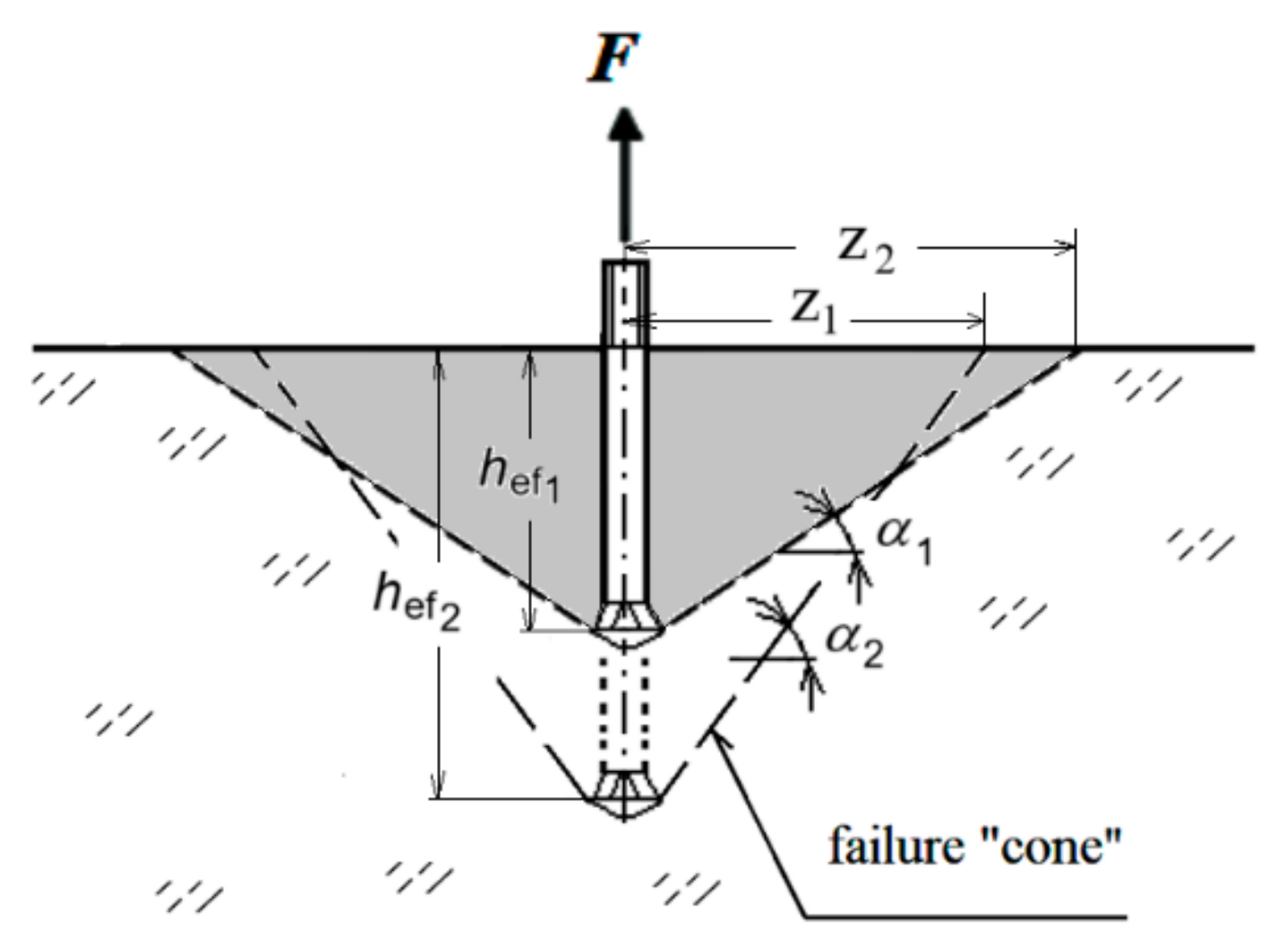

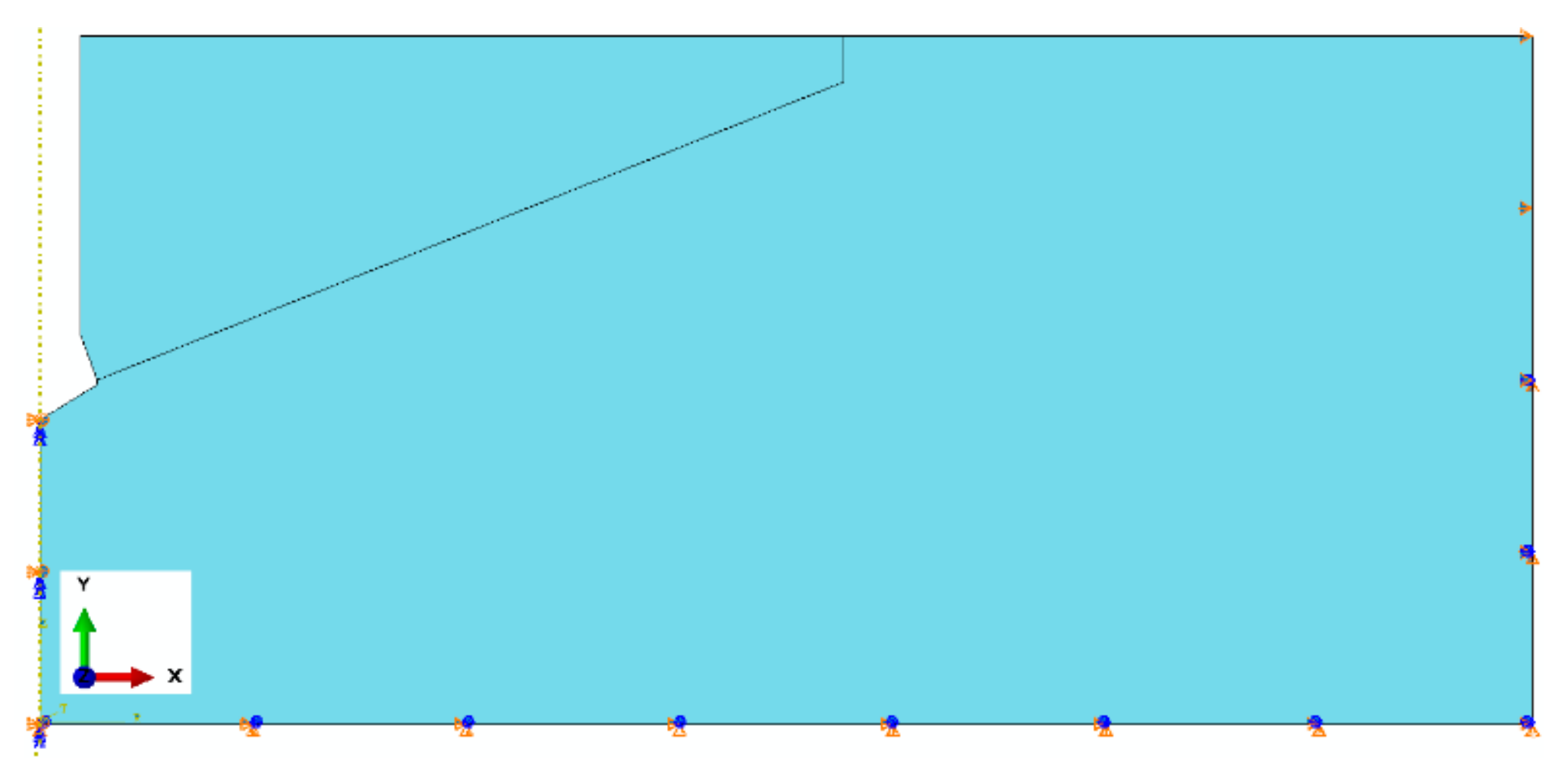
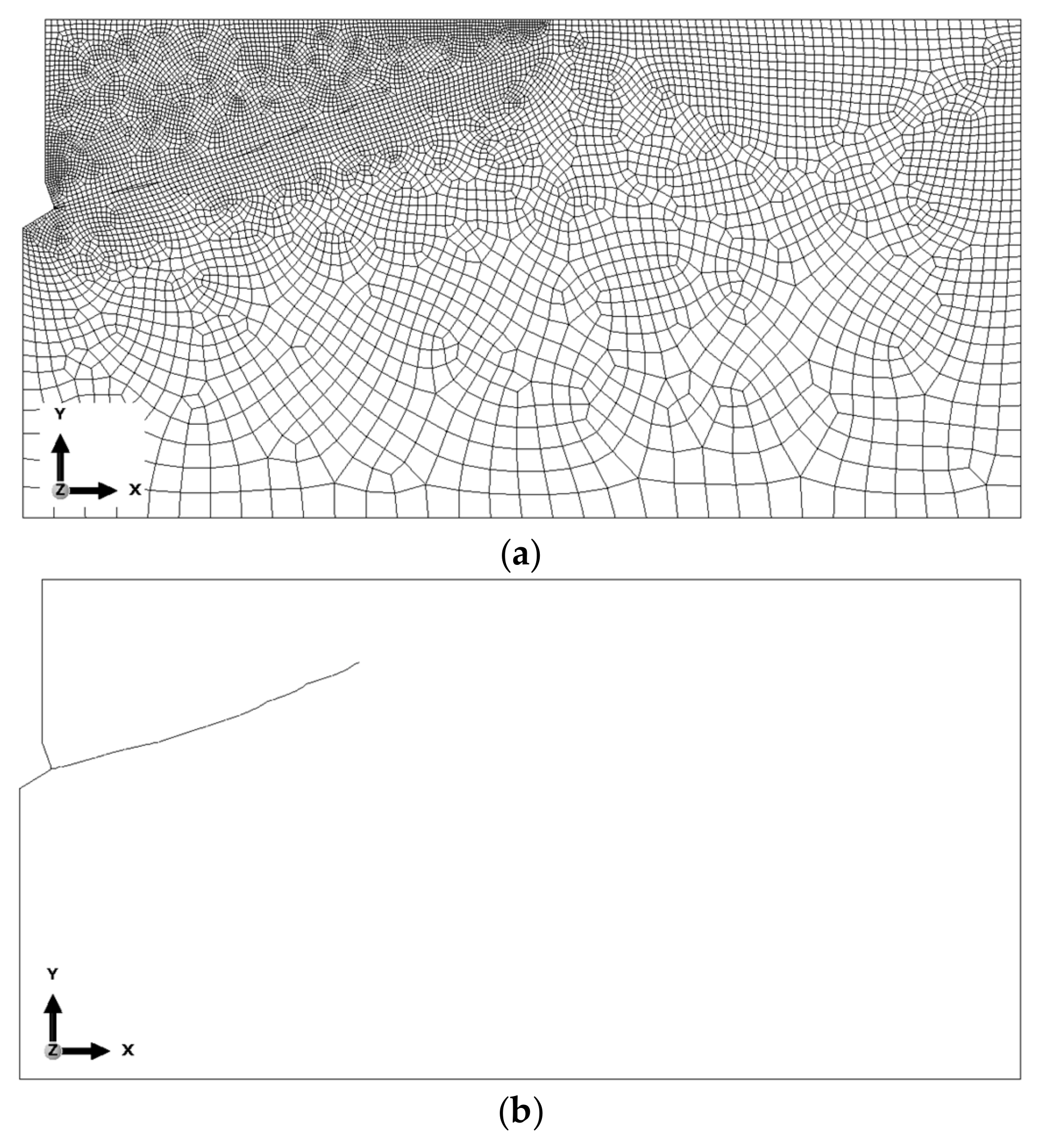

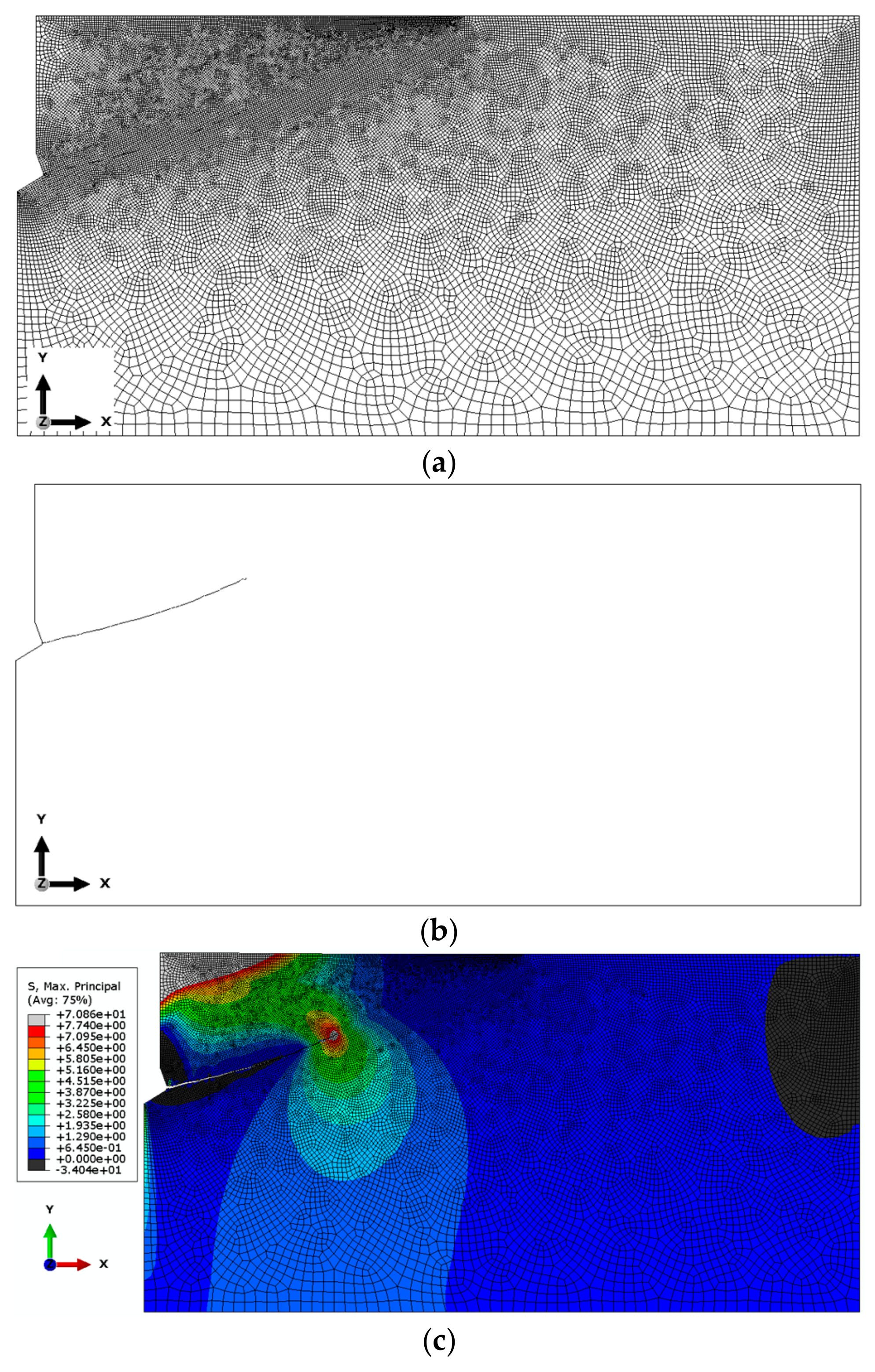

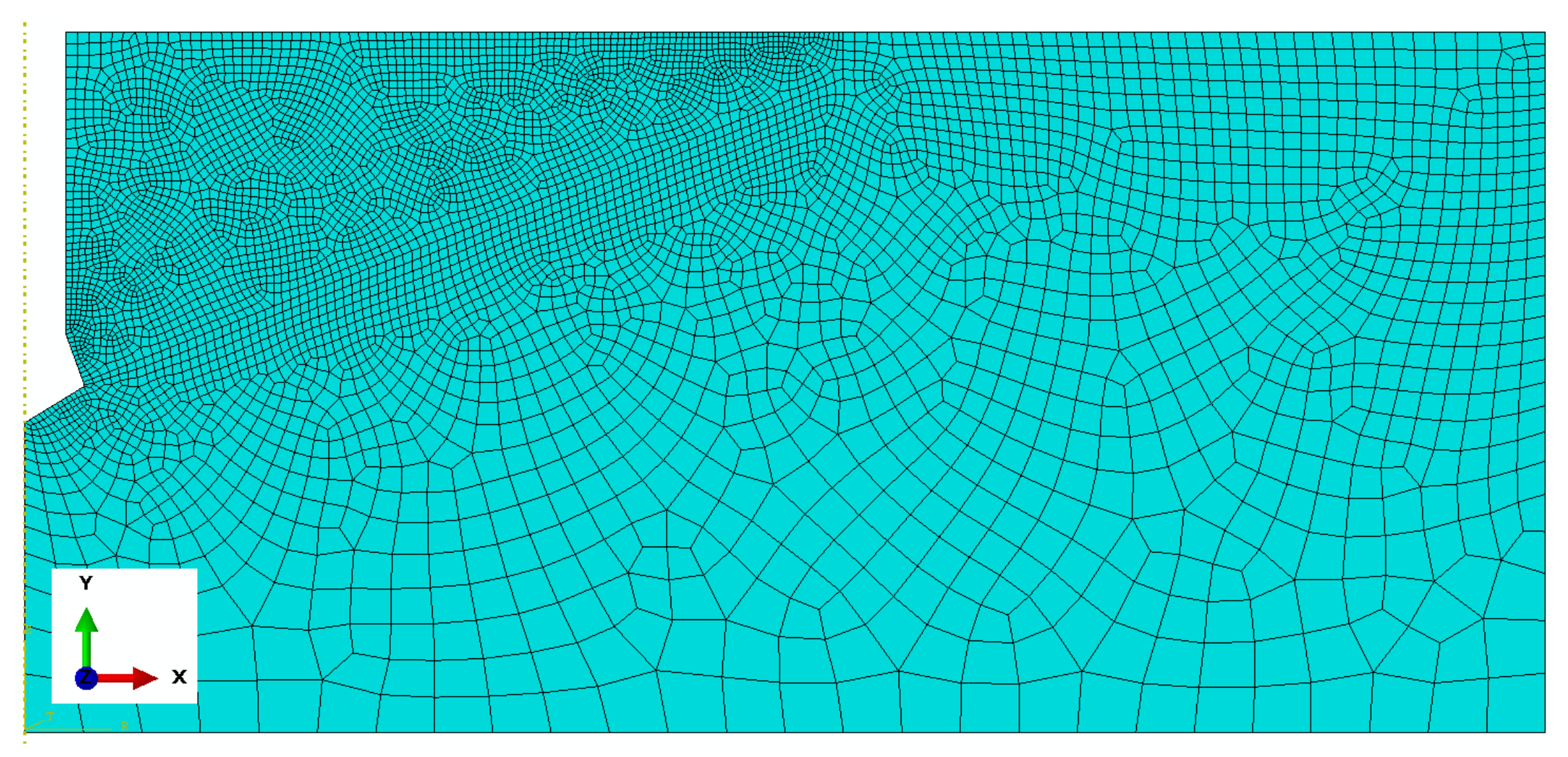
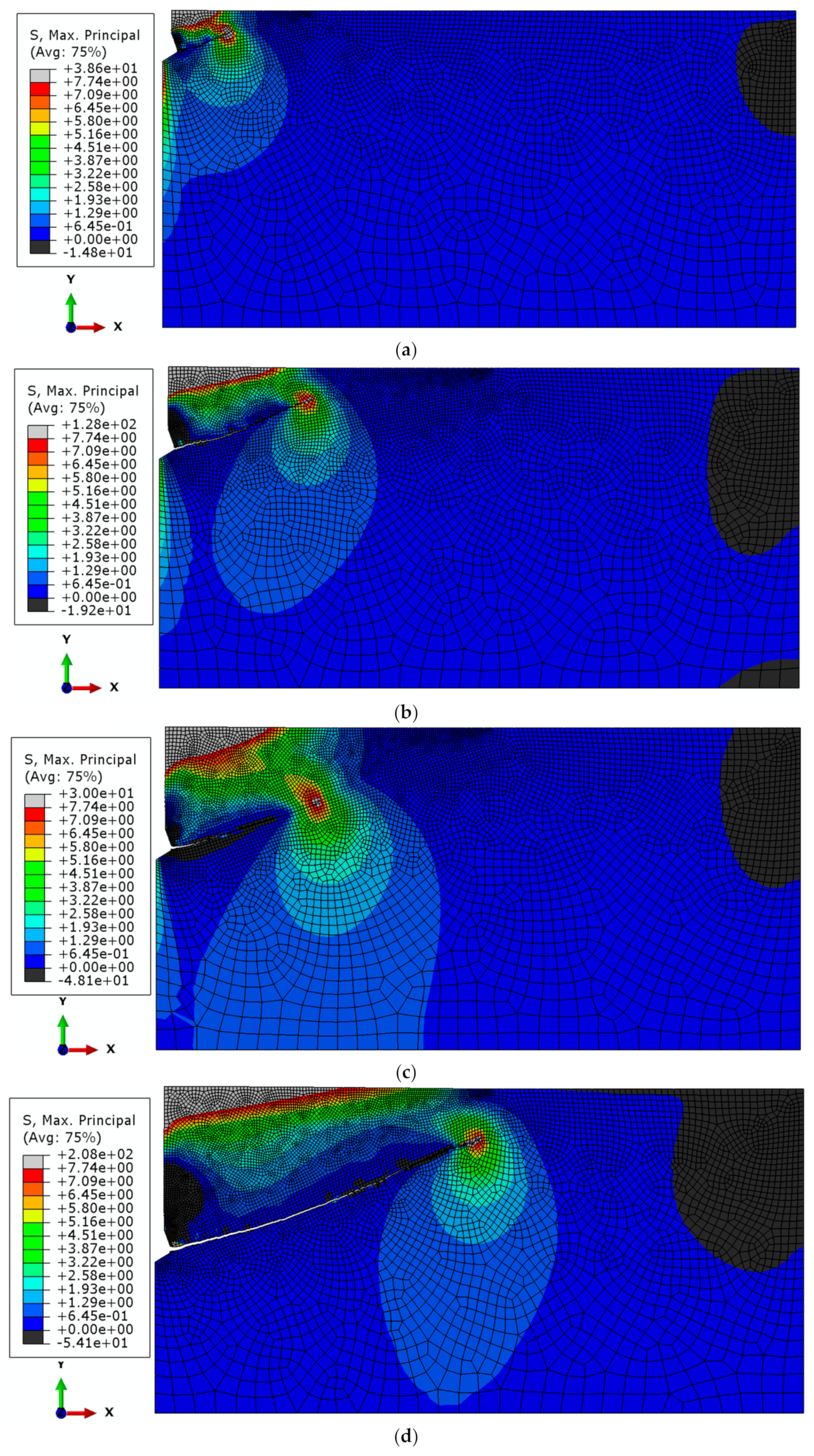
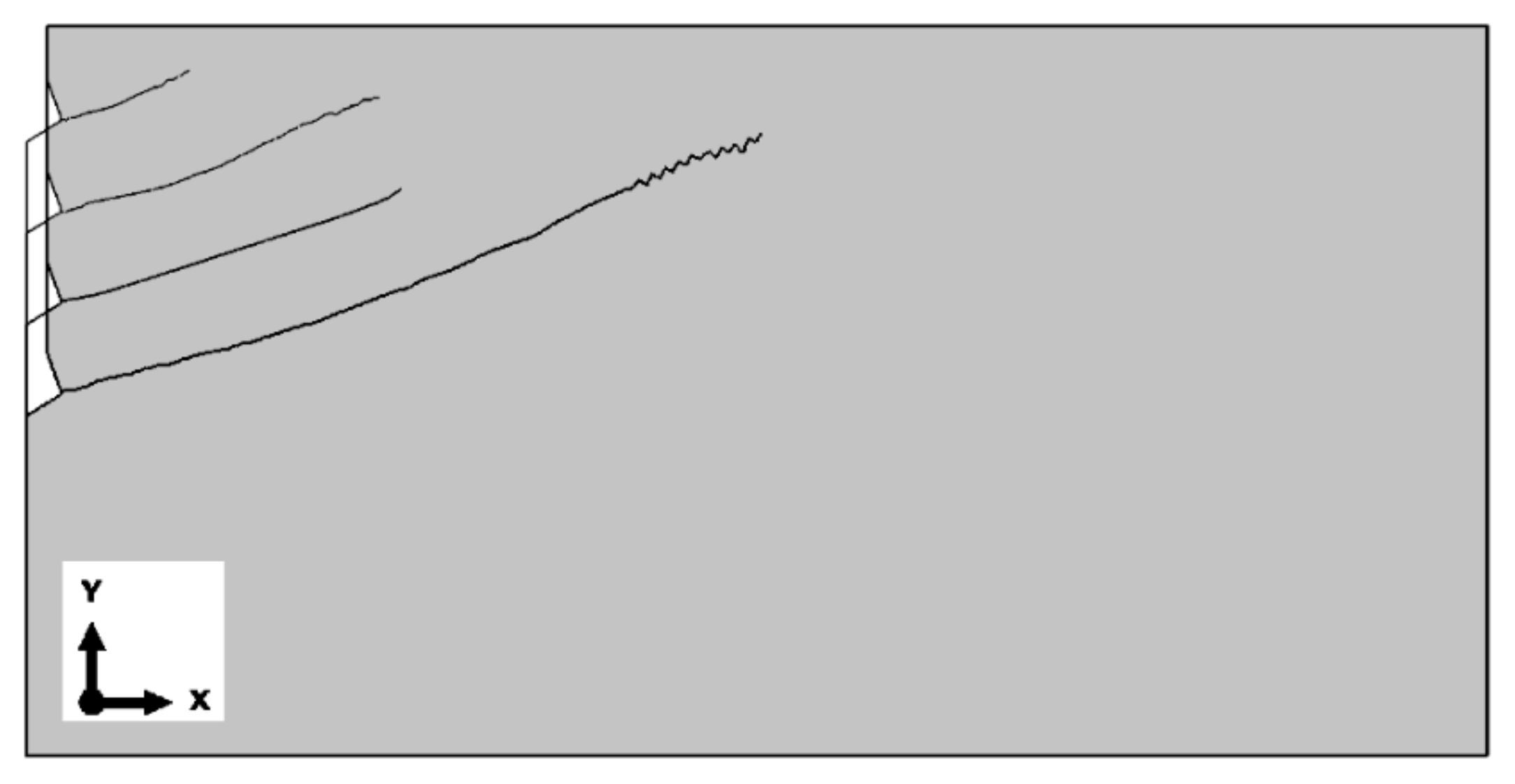
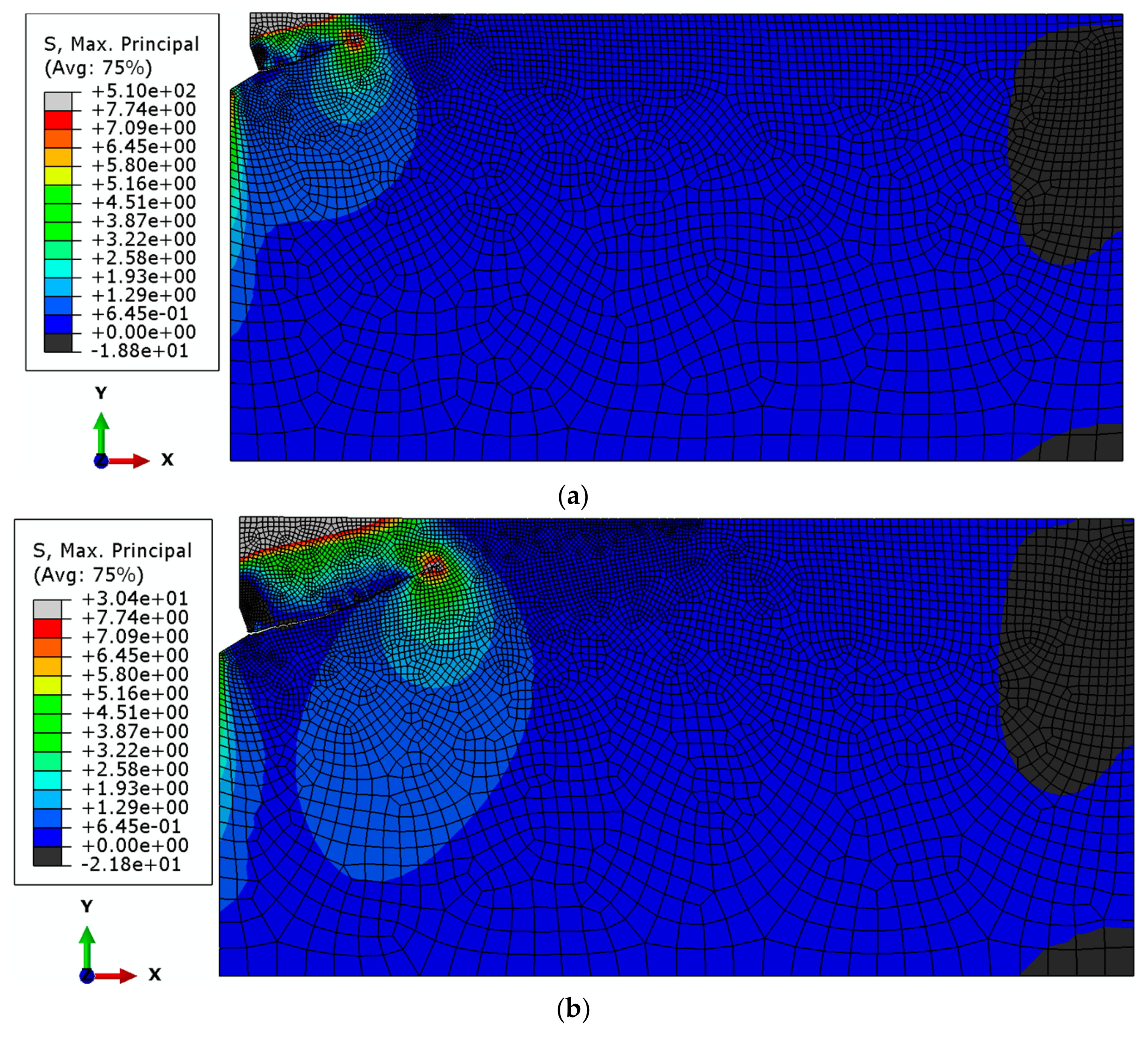
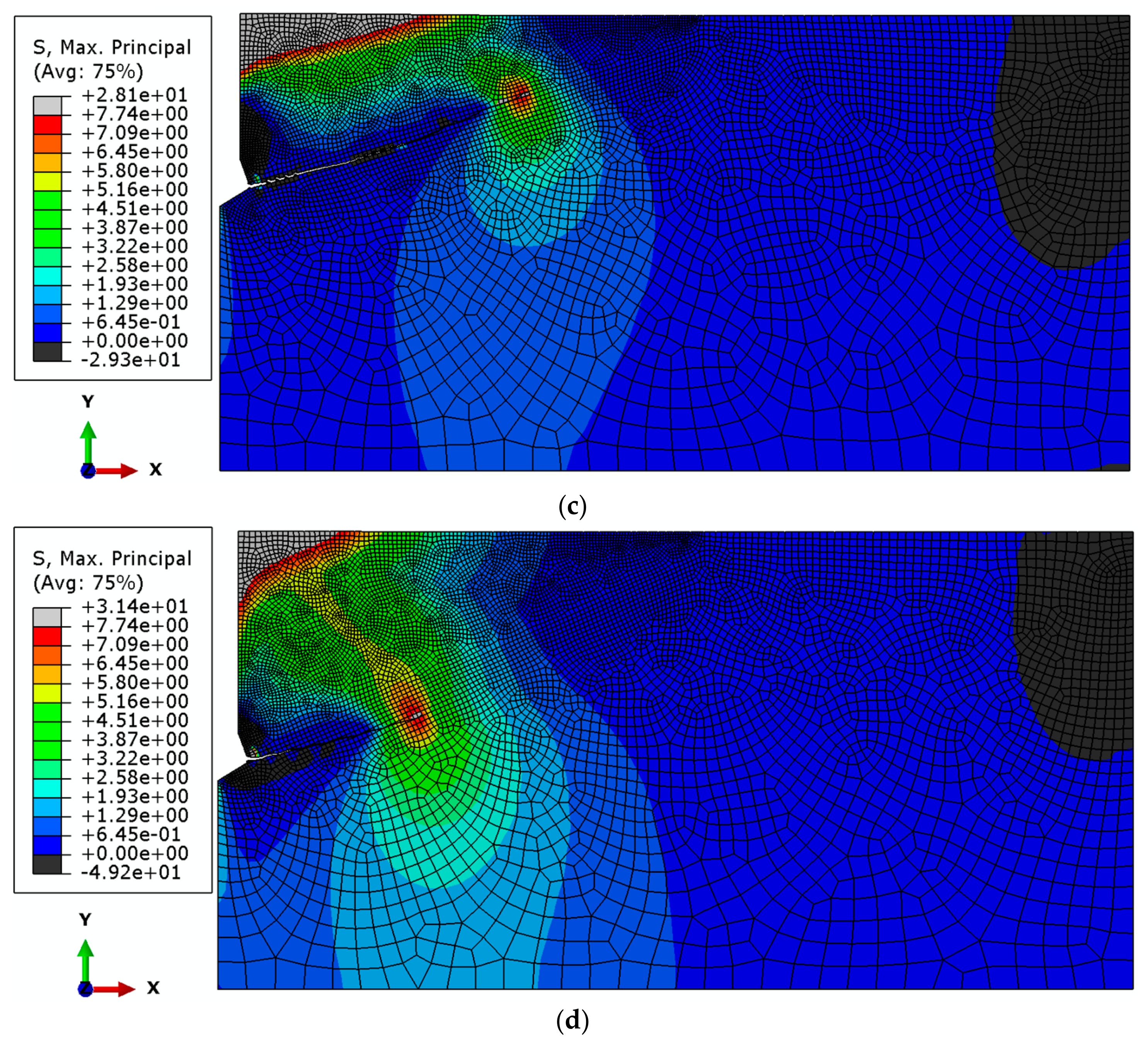


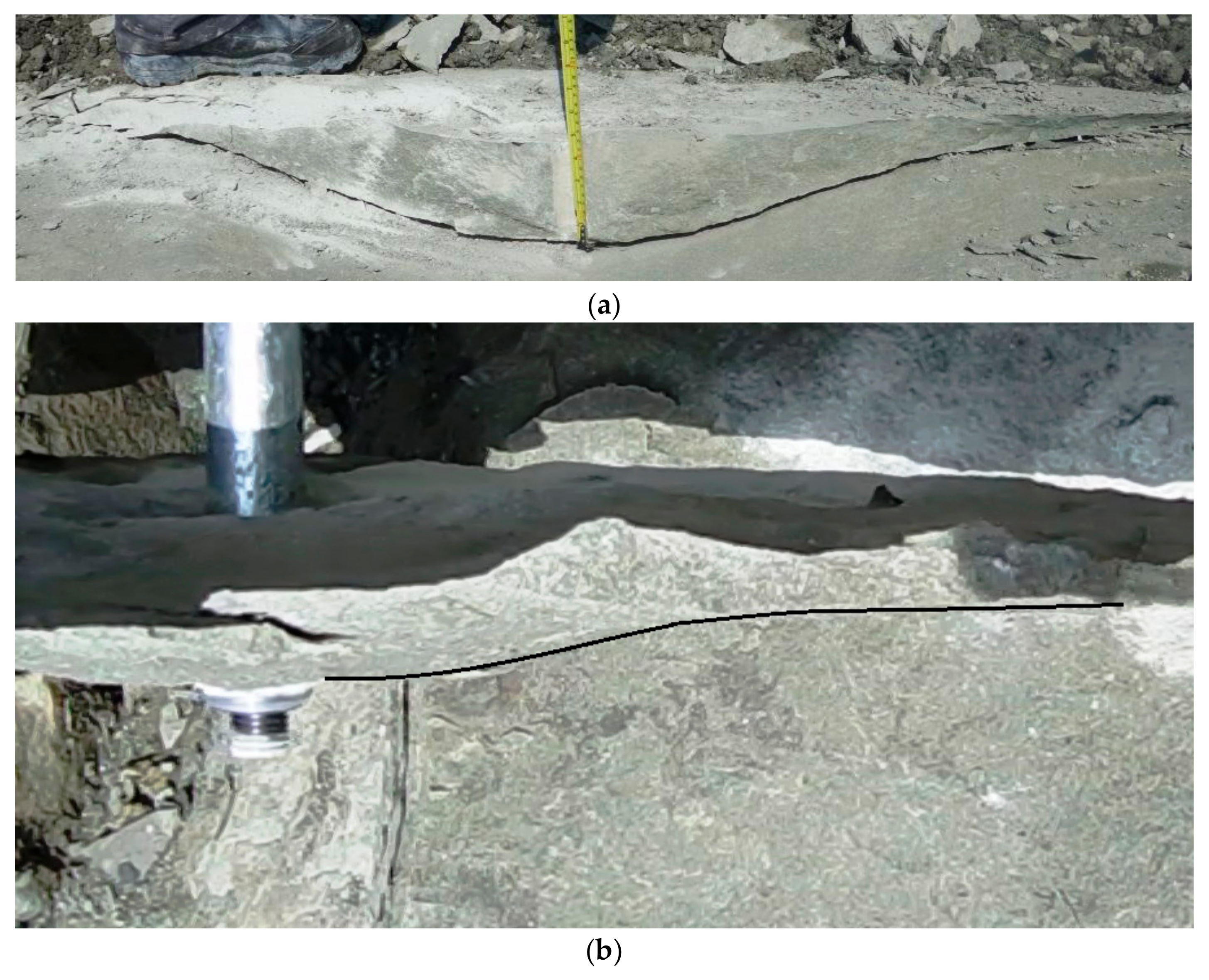

Disclaimer/Publisher’s Note: The statements, opinions and data contained in all publications are solely those of the individual author(s) and contributor(s) and not of MDPI and/or the editor(s). MDPI and/or the editor(s) disclaim responsibility for any injury to people or property resulting from any ideas, methods, instructions or products referred to in the content. |
© 2025 by the authors. Licensee MDPI, Basel, Switzerland. This article is an open access article distributed under the terms and conditions of the Creative Commons Attribution (CC BY) license (https://creativecommons.org/licenses/by/4.0/).
Share and Cite
Jonak, J.; Wójcik, A.; Karpiński, R.; Jonak, K. Effect of Undercut Bolt Anchor Depth on Failure Cone Geometry: A Numerical FEM Analysis and Experimental Verification. Materials 2025, 18, 686. https://doi.org/10.3390/ma18030686
Jonak J, Wójcik A, Karpiński R, Jonak K. Effect of Undercut Bolt Anchor Depth on Failure Cone Geometry: A Numerical FEM Analysis and Experimental Verification. Materials. 2025; 18(3):686. https://doi.org/10.3390/ma18030686
Chicago/Turabian StyleJonak, Józef, Andrzej Wójcik, Robert Karpiński, and Kamil Jonak. 2025. "Effect of Undercut Bolt Anchor Depth on Failure Cone Geometry: A Numerical FEM Analysis and Experimental Verification" Materials 18, no. 3: 686. https://doi.org/10.3390/ma18030686
APA StyleJonak, J., Wójcik, A., Karpiński, R., & Jonak, K. (2025). Effect of Undercut Bolt Anchor Depth on Failure Cone Geometry: A Numerical FEM Analysis and Experimental Verification. Materials, 18(3), 686. https://doi.org/10.3390/ma18030686




